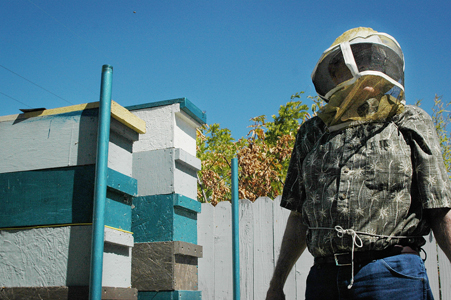
Africanized bees can wreak havoc on commercial hives
While the hype of African bees has been focused on the threat to
humans, the bigger threat may be to the bee species commercial
beekeepers and hobbyists employ.
Africanized bees can wreak havoc on commercial hives
While the hype of African bees has been focused on the threat to humans, the bigger threat may be to the bee species commercial beekeepers and hobbyists employ.
Bees in San Benito County serve dual purposes. While there is some commercial honey production, the county Agriculture Commissioner’s office is unable to assign a value because there are so few beekeepers that their revenues are not publicly reported.
The lion’s share of the local bee business focuses on pollination for orchards and other ag applications, which will not be adversely affected by Africanized bees taking over hives, said Bill Coates, a farm advisor with the University of California Davis Cooperative Extension in Hollister.
If the current population of European honeybees is converted to Africanized bees, they are still good pollinators and a fairly hearty species at that, albeit more difficult to handle, Coates said.
Who will be hit are backyard beekeepers, such as Hollister’s Leon Bray, who has been raising hives for the past 40 years.
“One source I read said that when you’re dealing with African bees there are 25 percent more stings, 25 percent more work and 25 percent more sweat, so they’re harder to handle overall,” Bray said.
The first bees brought to the Americas were from Europe, which were stay-at-home insects that rarely swarmed or abandoned their nests. The Africanized bees were developed in Brazil in hopes of making inroads as a honey-exporting region.
A Brazilian doctor, Warwick Estevam Kerr, traveled to Africa to locate tropical honeybees and bring them back to Brazil. All was stable until a visiting beekeeper removed some barriers that kept the queens from escaping. Roughly two dozen Africanized queens – accompanied by swarms of workers – left the hives and began to migrate north.
The Africanized bees arrived in the United States in 1990, taking only a little more than 40 years to make the journey. They first arrived in Texas and have spread throughout the states since then.
Though the first colony of Africanized bees was discovered in San Benito County last month, Bray said that they might have been here longer.
Last month a north county property owner found bees living in an old pump house near Foothill Road. After being stung several times, the property owner called a Prunedale beekeeper to destroy the swarm.
It was thought that extreme temperatures would thwart the bees from migrating into the Northern hemisphere, but Bray said that since the bees are originally from Africa, their tolerance to extreme weather variances is high.
“Some researchers thought the cold would be a deterrent, but not so as long as there is something for them to eat, and in California there’s always something to eat,” Bray said.
Africanized bees defend colonies more aggressively than other types of bees. It takes very little to disturb them and once provoked they are like a drunk looking for a fight. But left unprovoked, Africanized bees are on par with other honeybees.
One of the problems facing beekeepers is that while European bees typically won’t attempt to go into Africanized colonies, the behavior of Africanized bees is to move their queens into other European hives and kill off those queens producing hybrid bees.
“Eventually, the African bees will wipe out all other types of bees here. It’s just a matter of time,” Bray said.
Bray said he will likely have to quit his hobby.
“If hives get too ferocious, I think we’ll just give it up and backyard beekeepers will fade away,” he said. “Beekeeping as a whole is not a great industry; there are long hours and the money isn’t that great, but bees are very sophisticated. It’s a labor of love.”
Safeguarding you and your family
At the present time San Benito County doesn’t have an infestation of Africanized honeybees. Below is a list of precautions residents should keep in mind.
Treating Stings:
· Remove the stinger quickly, scrape it out with a fingernail or credit card, do not release more venom by squeezing the stinger.
· Wash the affected area with soap and water. Apply an ice pack to relieve pain and swelling.
· See a doctor immediately if breathing is difficult, if you are stung several times or if you are allergic to bee stings.
Avoiding an Attack:
· Obtain bee sting kits (over the counter or prescription).
· Remain alert for bees while participating in outdoor sports, games and other activities.
· Look for bees in work areas, yards, pens and other buildings before using power equipment.
· If attacked, run away in a straight line, cover your face and eyes with a jacket and hide in a car or house if a bee or swarm begins to chase you.
Source: California Department of Food and Agriculture









